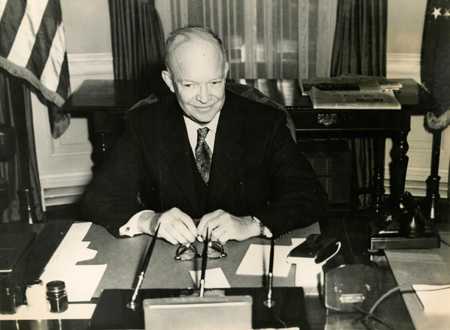REITs have helped shape communities and the real estate investment landscape for the past six decades
Since their inception 60 years ago, REITs have helped shape the communities where they own, develop, and operate a wide range of commercial real estate assets. In addition to helping communities grow and revitalize, REITs have also played an important role in investment portfolios for millions of Americans by expanding the boundaries of who can invest in real estate and providing competitive total returns and stable income.
The variety of projects that REITs are involved in show that when REITs invest in projects within communities, the benefits extend beyond the company and tenants and shareholders.
Not all of those projects, however, are limited to physical assets. For example, logistics REIT Prologis, Inc. (NYSE: PLD) has invested in innovative workforce development to address a pressing need for labor within its key markets, while providing students with vital skills for future careers.
Other REIT projects highlight the expertise the industry can bring to unique operating environments. Case in point, Ryman Hospitality Properties, Inc. (NYSE: RHP), which is helping preserve Nashville’s legacy as the home of country music by bringing new audiences to the city’s renowned landmarks. Meanwhile, at JFK Airport in New York, the once-defunct TWA Flight Center has undergone a meticulous $265 million renovation by private REIT MCR to emerge as the new TWA Hotel.
At the same time, infrastructure REITs are using 5G wireless technology to build and support digitally connected communities. And in Hawaii, Washington Prime Group Inc. (NYSE: WPG) has renovated an aging regional mall by acknowledging the local community’s unique heritage.
Through the process of building and connecting communities, REITs also create new jobs encompassing everything from retail sales personnel and property management to temporary construction, while also attracting top-tier talent to communities.
“We are making a huge impact on the built environment of the cities we operate in, working closely with our communities to come up with projects that enhance cities,” says Owen Thomas, CEO of Boston Properties, Inc. (NYSE: BXP).
Democratization of Real Estate
Approximately 145 million Americans, or roughly 44% of American households, are invested in REIT stocks directly or through their collective savings vehicles like mutual funds. The numbers reflect the enduring appeal of the REIT approach to real estate investment.
“REITs have really shown that they can democratize commercial real estate so that everyone can invest in an income-producing asset that previously could only be owned by wealthy corporations or individuals,” says Debra Cafaro, chairman and CEO of Ventas, Inc., (NYSE: VTR).
Thomas agrees. “Anyone who can buy a share of stock can own commercial real estate,” he says.”
Over the course of the last 60 years, REITs have proven to be one of the best long-term asset classes. Between 1972 and 2020, compound annual total returns of the FTSE Nareit All Equity REITs Index rose 11.41%, compared with 10.72% for the S&P 500. REITs of all types collectively own approximately $3.5 trillion in gross assets across the U.S., with public REITs owning approximately $2.5 trillion in assets, representing more than 500,000 properties. U.S. listed REITs have an equity market capitalization of more than $1 trillion.
According to Mike Kirby, co-founder and director of research at Green Street, total returns generated by equity REITs have consistently stacked up favorably versus “virtually every other investment alternative” during the last few decades. “This is particularly true with regard to performance versus other real estate investment vehicles, as REITs have trounced what private investment options have delivered,” he adds.
Part of this growth stems from the versatility of the REIT structure and its increasing global appeal to investors.

“The past 30 years have seen a dramatic shift in commercial real estate from the private sector to public markets, driving substantial growth of the global real estate securities market,” explains Robert Steers, CEO and co-founder of Cohen & Steers, a specialist asset manager. “We’ve seen increasing adoption of the modern REIT structure around the world amid growing investor demand for listed real estate and global real estate allocations,” he says.
Indeed, real estate markets have opened up to private individual investors across the globe, changing the way the world views investing and who can invest. Today, 40 countries have put in place REIT legislation.
“The adoption of the REIT model globally shows it fills a vital need in the market for broad investor access to real estate. REITs allow for portfolio diversification, meaningful dividends, liquidity, and transparency,” says Bill Stein, CEO of Digital Realty Trust, Inc. (NYSE: DLR) and the 2020 Nareit chair.
Leading With Transparency
Since its founding in 1960, Nareit has served as the worldwide representative voice for REITs.
“We can all look to Nareit’s and the broader industry’s high standards when it comes to integrity and responsibility,” Stein says. “Over the decades, that culture of stewardship has helped keep us as a trusted partner to investors.”
One reason the industry has been successful is the transparency and alignment of interests that are associated with the public market, Kirby says. By going public, many companies have ushered in a new era of transparency and taken on leadership roles in setting market standards.
“Transparency is a huge advantage,” agrees Don Wood, president and CEO of Federal Realty Investment Trust (NYSE: FRT), one of the earliest REITs, founded in 1962. “Figuring out how to invest in real estate isn’t easy, but in a REIT model, it’s all laid out for you. The REIT model works.”
Thomas notes that being a large cap public company also means you are setting an example for the others. Public companies disclose business strategies, financial results, and leasing volumes, all of which provide a “benchmark” for private companies assessing their own performance, he notes.
One key aspect of this leadership has been health security during the COVID-19 pandemic. “We’re very much on the front lines of keeping our team members and customers safe as they return to work,” Thomas says. He credits Boston Properties’ approach with providing a model for pandemic management. “Being a REIT, having the funding and transparency, has allowed us to execute even better on health security measures.”
Commitment to Serve
Acknowledging and celebrating REIT success includes recognizing the industry’s role in giving back to the communities where it operates.
“We’ve been really lucky to grow an S&P 500 company over the 20-plus years of my tenure, and we felt it absolutely essential that we share the good fortune that we’ve had with our employees, with our communities, with our partners and of course with the patients and residents and others who live in or work at Ventas communities or facilities,” Cafaro says.
Communities have needed additional support during the coronavirus pandemic, and REITs have stepped up to aid in various ways.
“More people are struggling today to feed their families than ever,” Byron Boston, president, CEO, and Co-CIO of Dynex Capital, Inc. (NYSE: DX), explains. Boston and Dynex Capital partnered with three Richmond-based charities to provide funding for food at the local level.
At its Assembly Row urban, mixed-use development in Somerville, Massachusetts, Federal Realty filled an essential need by donating a parking lot for the deployment of a critical care decontamination system to help facilitate the city’s free outdoor testing program.
Thinking globally, Digital Realty made a $1 million philanthropic commitment to the International Red Cross Society and the World Health Organization’s COVID-19 relief funds, while making significant donations to six COVID-focused charitable organizations.
Ventas also took a hands-on approach to ensuring the safety of its elder neighbors in its communities which are home to more than 70,000 seniors throughout North America.

“We led our industry in making sure testing was available to seniors and frontline workers in partnership with the Mayo Clinic labs,” Cafaro says. Ventas also utilized the strength of its access to capital and relationships to source essential PPE to keep communities safe.
Strong Corporate Citizens
Beyond the pride of knowing they’re making a positive impact on their communities, REIT CEOs agree that good corporate citizenship also pays dividends from an investment standpoint.
“Being a strong corporate citizen definitely makes us a more attractive company for investment,” Thomas says.
Rather than being in conflict with the bottom line, corporate citizenship and working with communities through private and public partnerships go hand-in-hand with performance. Investments in sustainability initiatives have also been shown to increase asset longevity.
“Our company has always believed that doing the right thing is really synergistic with delivering good performance for stakeholders,” Cafaro says. “When you build relationships, when you do the right thing you are more likely to be successful and continue your license to operate.”
The last decade has seen an increased demand among investors for good corporate citizenship, with some of the world’s leading investors in REITs making a point in investing more in companies that have well-established track records on ESG, which has both enhanced stakeholder capitalism and the communities in which REITs operate. “Giving back and bottom line are one in the same,” Wood says.
Future Flexibility
According to experts, one of the high points of the industry’s 60 years has been the public market’s willingness to embrace newer property types, along with the ability of REITs to adapt and evolve to the demands of ever-changing markets and consumer demand.
The last decade, for example, has seen the emergence of new specialty property types such as cell towers, data centers, logistics warehouses, health care, and student housing.
“REITs play a key role in creating access to the new economy, notably, the increased need for technology and interconnectedness in society,” Stein says.
Cafaro describes the REIT model as “flexible enough and forward-thinking enough to umbrella over all these asset classes. As our economy has changed and grown, the REIT model has been flexible enough to change and grow with it.”
More types of real estate assets are finding funding in the REIT market, according to Thomas. “Starting in the ‘90s, many types of “core” real estate used the REIT market as a source of funding for their businesses. Now that group is less than 50% of the total market cap and you’re seeing a broad expansion of the types of real assets that are finding funding there,” he says.
Given the flexibility of the REIT structure and the adaptability of the market, the future looks promising. “Business follows demand. As demand changes, businesses change,” Wood explains. “The broadening of what’s available to the investment market is a real positive for all REITs,” he adds.
Cafaro agrees. “I would expect to see in the coming decades, that continued evolution of the REIT model to go where the economy and where commercial real estate is going and growing,” she says.
An Industry Evolves
The story of REITs begins with a swipe of a pen from President Dwight Eisenhower, making the REIT Act title law under the Cigar Excise Tax Extension of 1960. It would come to represent a pivotal moment for the U.S. economy in the modern era.
While the untapped potential of the market and the flexibility of the REIT structure were clear from its inception, few predicted how successful the model would become.
Like any venture, REITs had their share of growing pains when early legislation was first introduced. “REITs struggled to gain traction as early laws placed severe limitations on how REITs could operate,” says Robert Steers, CEO and co-founder of Cohen & Steers.
In the 1980s, crucial tax reforms made the REIT structure more appealing to both property companies and investors, and legislation was simplified to provide companies with greater flexibility.
The REIT industry remained small until a wave of more than 80 IPOs occurred in the 1990s, catalyzed by the previous real estate recession.
Those first companies in the 90s to go public were considered some of the most talented developers in the country, according to Mike Kirby, co-founder and director of research at Green Street. He credits them with ushering in a new phase for REITs.
“That era was critical in defining the listed REIT sector as the place populated by the best and brightest. The concurrent growth of capital market specialists/investors meant that public market capital was often cheaper than private capital, which set the stage for explosive growth over the next few decades,” he says.
Indeed, the success of U.S. REITs spurred new legislation across the globe in the new millennium. “The globalization of REITs offered investors a wide range of opportunities in markets with meaningfully different characteristics,” Steers says.




